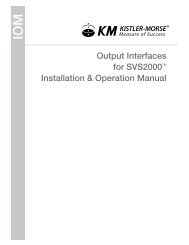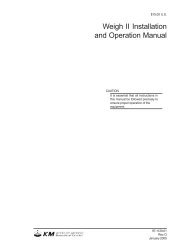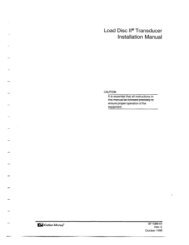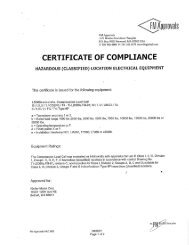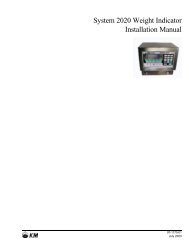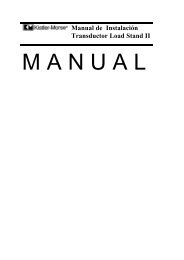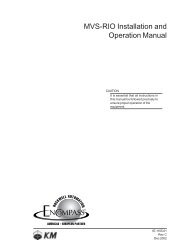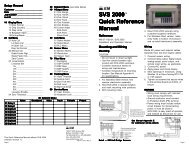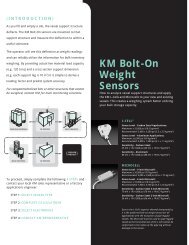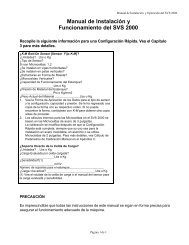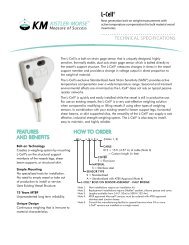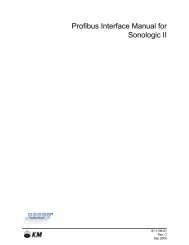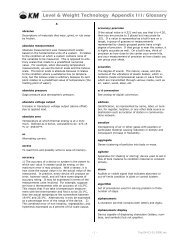STX Signal Transmitter Installation and Operation ... - Kistler-Morse
STX Signal Transmitter Installation and Operation ... - Kistler-Morse
STX Signal Transmitter Installation and Operation ... - Kistler-Morse
You also want an ePaper? Increase the reach of your titles
YUMPU automatically turns print PDFs into web optimized ePapers that Google loves.
Chapter 9. MVS-<strong>STX</strong> Math Channels<br />
Math Channel<br />
Functions<br />
Menu Functions<br />
C Identifies a specific channel in the<br />
equation. C must be immediately<br />
followed by a channel number (for<br />
example, C9 indicates the channel with<br />
factory-set ID# 9). All equations must<br />
start with the current channel designation<br />
<strong>and</strong> an equal sign (for example,<br />
C9= must be the start of the equation<br />
when you are in channel 9). When a<br />
channel number appears to the right of<br />
the equal sign, it tells the MVS to put<br />
the value from that channel (the weight<br />
from a vessel monitoring channel or the<br />
calculated value from a math channel)<br />
in the equation.<br />
+ Addition function. Adds the value to the<br />
right of the sign to the value to the left of<br />
the sign.<br />
* Multiplication function. Multiplies the<br />
value to the right of the sign by the value<br />
to the left of the sign.<br />
- Subtraction function. Subtracts the<br />
value to the right of the sign from the<br />
value to the left of the sign.<br />
÷ Division function. Divides the value to<br />
the left of the sign by the value to the<br />
right of the sign.<br />
= Equals function. Places the value from<br />
the entire equation to the right of the<br />
sign in the channel designated to the left<br />
of the sign. All equations must start with<br />
the current channel designation <strong>and</strong> an<br />
equal sign (for example, C9= must be<br />
the start of the equation when you are in<br />
channel 9).<br />
( Left parenthesis function. Used with<br />
right parenthesis to group math<br />
functions together.<br />
) Right parenthesis function. Used<br />
with left parenthesis to group math<br />
functions together.<br />
CLR Clear function. Clears the entire displayed<br />
formula from memory.<br />
Square root function. Takes the square<br />
root of the value to the right of the sign.<br />
ln<br />
e^<br />
Natural log function. Takes the<br />
natural log of the value to the right of<br />
the function.<br />
Inverse natural log. Takes the inverse<br />
natural log of the value to the right of<br />
the function.<br />
Keyboard Functions<br />
Up Arrow<br />
Scrolls to the left through the<br />
equation (MVS can only display<br />
16 characters in the equation at<br />
a time, <strong>and</strong> the scroll function<br />
allows you to view equations<br />
that have more than<br />
16 characters).<br />
Down Arrow Scrolls to the right through<br />
the equation.<br />
<br />
Enter<br />
Deletes the character to the left<br />
of the cursor.<br />
Stores the current formula<br />
in memory.<br />
Equation Limitations<br />
Following are the limitations on the equations<br />
put into the math channels:<br />
• A single equation can be up to 40<br />
characters in length. A character is a<br />
number, a decimal point, or a function<br />
from the Math Menu. The example<br />
equation below contains 9 characters:<br />
C9=C1+10.<br />
• A single equation can contain a maximum<br />
of 3 constants (a constant is a<br />
numerical value, such as 1000).<br />
• A constant can have a maximum of<br />
11 characters.<br />
• Equations cannot contain any spaces<br />
between characters. The example<br />
below shows an incorrect <strong>and</strong> a<br />
correct equation:<br />
Incorrect (contains spaces)<br />
C9 = C3 + C4 + C6<br />
Correct (no spaces)<br />
C9=C3+C4+C6<br />
9-2



